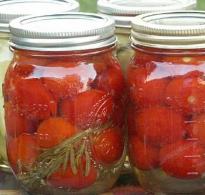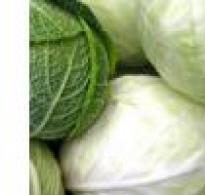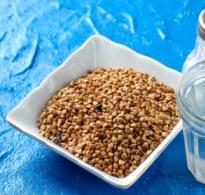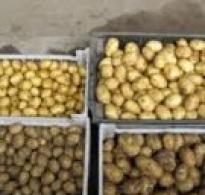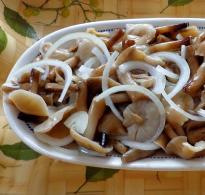The better cane sugar is from regular sugar. How white sugar is counterfeited to brown and why? What is Cane Brown Sugar
Sugar can be palm or sorghum and can be obtained from beets or malt. But originally sugar was cane sugar. About 3000 years ago in India they learned to squeeze juice from a tough tree-like grass - saccharum reed. It is thanks to him that the name of the sweet seasoning has penetrated into most world languages. In Greek - saccaron, in Arabic - sukkar. In the 18th century cane sugar disappeared from the territory of Russia. In our time, he returns triumphantly.
Correct dissolution
There is a myth that fake brown sugar colors the water while cane sugar does not. This is not true. Crystals cane sugar They are completely transparent, but their upper layers contain molasses, which gives the sugar a brown tint. When immersed in water, it is washed out first, staining the water. So if you bought sugar, which willingly shares its color, then you made the right choice.
How to choose a variety
The most common cane sugar is demerara. In 1913, at a court hearing in London, a decision was made: Demerara by the name of the most common variety. And this rule is still valid. If we are used to calling sugar cane or brown (brown, golden), then in the West it is called demerara. This variety is the benchmark for cane sugar.
In addition to demerara, there is black Barbados sugar, which contains the most molasses, therefore it is the most tart and aromatic. Muscavado variety with a bright caramel flavor is used mainly in gingerbreads, spicy muffins and toffee. Turbinado is a partially refined raw sugar from the Hawaiian Islands. The molasses is removed from its surface by steam or water, so the crystals look dry and crumbly, and the color varies from brown to golden. But today these varieties are exotic for our market. The most common varieties available to buyers are presented below.
Brown
The rich aroma of this sugar perfectly sets off the taste of coffee, giving it a deep exotic flavor. Golden crystals will be an excellent decoration for desserts and cocktails.
Brown universal
This sugar is intended for daily use instead of refined white sugar. It is suitable for any dish: it will give an amazing taste to baked goods, it will become a subtle note in meat roasts.
Brown fine
Due to its small crystals, it dissolves perfectly in water. Recommended for use in marinades, suitable for tea, coffee and fluffy, airy baked goods.
Brown lumpy
Served with tea or coffee, such sugar will become an exquisite decoration of the table, not to mention the rich caramel taste with which it can enrich these drinks.
Lumpy white
Refined cane sugar in a dazzling white color and as refined as possible. Such sugar will become a great addition to any hot drinks.
Perfect cane sugar
- Real cane sugar has a rich, rich caramel flavor and aroma.
- True brown sugar can only be unrefined. If the label says Refined Brown, then you have beet sugar in front of you.
- The dark color of cane sugar is due to the presence of molasses in its composition. It is contained in the upper layers of crystals, therefore, when dissolved in water, it stains it.
- Unlike beet sugar, real cane sugar is softer and crumbly - it absorbs moisture better and dissolves faster in water.
- Bright, refined taste cane sugar appears best in desserts and cocktails - from Daiquiri and Mojito to baked apples and creme brulee.
- Cane sugar perfectly sets off meat dishes giving them a deep, rich sweet and sour taste which is business card modern European cuisine.
Cane sugar- a sweet crystalline product obtained from the juice of a sun- and heat-loving plant called sugar cane, which looks like bamboo and has been known to mankind since ancient times. In fact, the production of cane sugar is much older than that of beet sugar. India is considered its homeland, from where it gradually came and was cultivated in other countries of the Middle East and the Mediterranean with the help of travelers and merchants, who always delighted residents with overseas delicacies. And later, thanks to the Spanish and Portuguese conquerors, it spread to the New World, the Caribbean islands, Madeira and Cape Verde. Until now, cane sugar has an extraordinary distribution throughout the globe.
Nowadays, in almost every supermarket or grocery store you can find this wonderful product. Photos of cane sugar are very often adorned with various articles and publications on the topic. healthy nutrition, and the popularity of this sweetener is gaining more and more momentum, urging fans of a healthy lifestyle to closely monitor the foods they eat and get rid of harmful and useless ingredients in their own diet.
Beneficial features
Useful properties of cane sugar, or rather, their a large number of and explains the popularity that this type of product has gained in our time. Indeed, if we compare the usual beet sugar with cane sugar, then the results laboratory research, as a rule, the palm is handed over to the overseas counterpart. Consider the benefits of cane sugar:

Which cane sugar is best?
In order to decide for yourself which cane sugar is better, you must first understand the manufacturing process of this product, as well as with what they differ from each other. different types cane sweets.
The main two types that are found on store shelves are:
- Refined reed white sugar- such a product goes through all stages of refining: from transformation into a syrup followed by filtration to evaporation and drying of the resulting white mass.
- Unrefined brown cane sugar - this has a different saturation of brown hue and is subject to very little refining.
It is the latter, called "raw cane sugar", that is becoming more and more popular. There are several types of unrefined sweetener:

Cane sugar gur
 To say that gur is natural cane sugar is a little wrong. This product came to us from India along with the gaining popularity of Ayurvedic lifestyle trends and is a thickened natural juice extruded very slowly (over approximately 3 hours) from the trunks sugar cane.
To say that gur is natural cane sugar is a little wrong. This product came to us from India along with the gaining popularity of Ayurvedic lifestyle trends and is a thickened natural juice extruded very slowly (over approximately 3 hours) from the trunks sugar cane.
The consistency and color of this sweetness resemble soft sorbet, which, however, does not exclude the presence of a small amount of sugar crystals in the product.
Gur, popular mainly in India, is produced by carefully pressing the raw materials, refining and thickening them by cooking. This method allows you to save in the composition of the consumed product maximum amount useful substances.
How to distinguish a fake?
Every consumer needs to learn how to distinguish fake cane sugar from a natural product. Counterfeiters very often nowadays try to disguise ordinary refined white sugar with caramel, giving it a brown tint. This is done for the sake of profit, because cane sugar costs an order of magnitude more expensive than its refined beetroot brother. Let's look at several ways to test cane sugar for originality:

Cooking use
The use of cane sugar in cooking has many diverse traditions associated with cultural and culinary specialties each country. In addition, the variety of this product does not make it possible to combine all varieties in one row, because each is so unique (including compatibility with various products), which can be considered a separate type of additive:

Cane sugar benefits and treatments
Many people, thinking about a healthy lifestyle, are wondering about the benefits and dangers of cane sugar, and make sure that cane sugar only causes positive reviews. That is why the question of whether to buy cane sugar is usually not worth it for them. And it’s right, because it’s not only delicious delicacy... Correct and regular use of this product can help in the prevention and treatment of many diseases.
 If you just replace any sweetener with cane sugar in your diet, then the risk of complications such as:
If you just replace any sweetener with cane sugar in your diet, then the risk of complications such as:
- cough;
- sore throat;
- pulmonary infections.
Also this sweet product leads to improved blood circulation and strengthening of immunity.
This, however, is not surprising at all! The very history of this product indicates its medicinal nature. For a long time, cane sugar was only available for purchase in pharmacies as a medicine, not a culinary product.
The harm of cane sugar and contraindications
 The harm of cane sugar and contraindications to its use are the subject of research by many modern scientists and nutritionists.
The harm of cane sugar and contraindications to its use are the subject of research by many modern scientists and nutritionists.
In fact, this wonderful product has no contraindications. Restrictions in the use of cane sugar can only be associated with its excess amount in the daily diet, which leads not only to the appearance of excess fat in the human body, but also to additional stress on the pancreas, as well as to blood glucose oversaturation. This, in turn, can lead to various other diseases. In addition, the unregulated consumption of cane sugar by people with diabetes can exacerbate this disease and worsen the general well-being of a person.
3Diets and healthy eating 22.03.2018

Dear readers, many of you cannot imagine your life without sugar. Surely you know that it can be not only classic white, but also brown. This sugar is called cane sugar, and it is obtained from sugar cane, which grows in India and Cuba. It has a beautiful golden color and caramel flavor. Gourmets like to drink coffee and tea with cane sugar; many add it to homemade cakes to give a special aroma.
Today it is fashionable to buy organic products, and manufacturers actively support the idea healthy eating, which ignited the population. But it's not customary to talk about the risk of buying a fake. All types of cane sugar can be ordered in supermarkets and on the Internet, but how can an inexperienced consumer distinguish a high-quality product from a low-quality one? And what is cane sugar good for and is it good at all? Should you give up beet sugar? Let's understand this difficult issue. Let's talk about the benefits and dangers of cane sugar, about their differences.
A bit of history
Russian consumers learned about cane sugar back in the 90s, when it was actively imported to us from Cuba, and it cost even a little cheaper than our regular beet sugar. His homeland is India. It was brought to Europe by Alexander the Great. In the Middle Ages, sugar was sold in pharmacies. Peter the Great opened the Sugar Chamber in Russia in the 18th century. The world produces 60% of cane sugar and 40% of regular sugar.

The main types of cane sugar:
- Demerara- the most common finely ground cane sugar, has a fine delicate taste, suitable for coffee and cooking meat with appetizing sugar icing;
- Muscovado - elite grade cane sugar that is exposed minimal processing, has a rich characteristic sour caramel-vanilla aroma;
- Turbinado- raw cane sugar of a brownish-golden color, which is subjected to partial purification from molasses with the help of water and steam;
- Barbados- has a dark shade and strong aroma, contains a large amount of molasses.
Let's see what brown cane sugar looks like in the photo. It can be made in the form of refined or friable.


Cane sugar and beet sugar - what is the difference
What is the difference between cane sugar and regular sugar? This issue is of particular concern to those people who adhere to the principles of healthy eating. What's the difference? The main difference, of course, is in the line-up.
Brown cane sugar is the unrefined, unrefined sugar in which most of the nutrients:
- cellulose;
- calcium;
- zinc;
- potassium;
- B vitamins;
- sodium.
V regular sugar less calcium and other nutrients. But you should be aware that cane sugar can be not only brown, but also white (refined). The benefits of such a product are small. If you use cane sugar for health, then it is better to choose dark varieties(unrefined and unrefined). Then there will be no harm from the product, provided it is used in moderation.
Classic brown cane sugar gives unique taste our favorite drinks are coffee and tea. It is also used for making baked goods with a crispy crust, which is obtained thanks to the presence of molasses.
Calorie content
The calorie content of cane sugar does not differ from the usual one: about 400 kcal per 100 g. Still, sugar is a simple carbohydrate that needs to be consumed in small quantities, and with age it is recommended to abandon it altogether or sharply limit it.
How much cane sugar can you eat per day
The daily rate of sugar per day (not only in the form of a bulk product, but also in the form of baked goods) is no more than 5 teaspoons. Excess glucose can harm the body, in particular, according to experts, it makes our blood vessels fragile and contributes to the development of atherosclerosis. In addition, after sugar enters our body, calcium is spent for its processing - the main element for maintaining healthy teeth and bones.
Which sugar is sweeter - cane or beet sugar
In terms of the degree of sweetness, beet sugar is richer, it is really sweeter. It is spent more economically at home. Cane sugar is less sweet, tastes softer, and works well in coffee and baked goods. Homemade muffins and cookies are especially tasty when added. If you need to choose sugar according to the degree of sweetness, then it is better to buy beetroot. Reed is loved precisely for the combination of its special aroma and taste.

The main useful components of cane sugar are calcium, iron, potassium, magnesium and B vitamins. There are a lot of these substances in this product. Per 100 g, it contains approximately 62 mg, 332 mg, 117 g, 2 mg. But it is not worth eating in such an amount of sugar just for the sake of obtaining useful substances - it is healthier and safer to get them from other products.
The main beneficial properties of cane sugar:
- strengthens bones, prevents the development of caries and tooth loss, inhibits the course of age-related osteoporosis;
- gives useful energy, increases efficiency, restores strength after hard physical work and psycho-emotional stress;
- increases immunity, enables the body to actively repel viral attacks, inhibits the aging process due to the presence of antioxidants and B vitamins in the composition;
- ensures normal functioning nervous system and the brain;
- regulates metabolic processes in the body, supports hematopoietic function;
- normalizes the work of the digestive tract due to the content in the composition natural fiber, clears the intestines of mucus and harmful products metabolism;
- due to the presence of potassium, cane sugar supports the active work of the heart muscle, prevents the development cardiovascular disease.
Cane sugar is especially beneficial for knowledge workers who need a regular supply of glucose. Than there are sweets and high-calorie pastries, it is better to add a piece of refined sugar to the tea. This will benefit the brain. I myself like not to add it to tea, but to drink a bit.
You know, you can't live without sweets either, but you need to be able to find an alternative to harmful carbohydrates. Since there is a lot of calcium in the composition of cane sugar, when glucose is absorbed, its own calcium reserves will be consumed at a slower rate. This is a great advantage in my opinion.
This video describes the benefits of brown cane sugar, its types and possible harm for health.
Which sugar is better - cane or beet sugar?
This is a traditional question of concern to many consumers. Refined sugars are all equally harmful. But unrefined cane is many times more useful. It has 23 times more calcium than refined sugar. If only because of this, it is worth giving preference to sugar made from cane juice.
How to choose the right cane sugar
Today the demand for this product has grown significantly, but not all consumers are able to choose a quality product. Be sure to check the packaging: proven cane sugar producing countries - Mauritius, Latin America and Cuba.
How to distinguish a fake from an original
There are many myths regarding the definition of the quality of cane sugar. On the Internet, many even conduct various experiments at home, but, alas, their results are not always reliable. For an inexperienced consumer who has never bought a similar product before, it is difficult to distinguish a fake cane sugar from the original.
It is believed that The best way quality tests of cane sugar are attempts to dissolve it in water, which many believe should remain clear. In fact, such experiences cannot be taken seriously. Cane sugar contains molasses, which colors the liquid. This is an absolutely natural reaction.
You should also be skeptical about the experiment with iodine, which should color the starch contained in cane sugar. But there is so little of this starch that you can hardly see the blue coloration of the water.
What to look for when buying cane sugar? I would advise looking at the price. The main difference between cane sugar and ordinary sugar is its qualitative composition. But a good product can't be cheap. Therefore, if the cost of cane sugar is suspiciously low (less than 250-300 rubles per kg), it means that in front of you, most likely, ordinary colored sugar.
It's important to feel and see the line between the health benefits and harms of cane sugar. Only moderate consumption of the product can be safe for health.
Cane sugar is a kind of exotic, delicacy for gourmets and those who want to minimize the harm from carbohydrates consumed. But these are not fruits or vegetables that can be consumed with almost no restrictions. I know that some people eat cane sugar in chunks, and this is understandable: it has a unique caramel taste and you just want to eat it. But always remember about a sense of proportion, which will help to maintain a figure, and blood vessels, and not to earn insulin resistance, from which many begin to plump catastrophically quickly.

Is cane sugar possible for diabetes
At diabetes mellitus limit any sugars, including cane. You can eat simple carbohydrates with the permission of an endocrinologist. Diabetes mellitus increases the risk of obesity and cardiovascular diseases, so it is better to replace sugar with honey, which contains more fructose than sucrose, or use sweeteners. The severity of the restrictions directly depends on the severity of the disease. Therefore, in any case, it is better to consult with your doctor.
Sugar isn't just sweet. Sugar is the joy of our lives
There are many ways to use cane sugar. The most common option is to add the product to tea and coffee. To give culinary dishes caramel flavor and subtle aroma, cane sugar can also be used.
Homemade cookie recipe
You will need the following products:
- 1 egg;
- 1/2 cup powdered sugar
- 100 g sifted flour;
- 1/2 cup cane sugar
- 120 g soft butter;
- a glass of raisins;
- a pinch of vanillin;
- 1/2 cup oatmeal
- a pinch of salt.
Mix soft butter With icing sugar and brown sugar. Add beaten egg, vanillin, oat flakes and flour. Then add the raisins and salt to taste. Stir the mixture thoroughly, form into neat cakes, place on a baking sheet and place in a preheated oven to 200 ° C. You need to bake cookies before golden crust(10-20 minutes).
Sweet epilation
Brown sugar can be used not only in cooking, but also in cosmetology - it turns out good pasta for . With its help, it is easy to remove excess hairs on the body. Cane sugar syrup caramelizes quickly, so it can be used for home hair removal if desired.
For classic pasta you will need: 6 tablespoons of brown sugar, 2 teaspoons of water, 2 tablespoons of lemon juice. Simply combine all ingredients (except lemon juice) and melt over low heat until caramelized, stirring frequently. Lemon juice add to the mixture immediately after the sugar boils, when the surface is covered with bubbles. Refrigerate the composition for several hours. Mash before use small piece paste to the state of plasticine.
How to store
Due to its high hygroscopicity, it is recommended to store cane sugar in a glass or ceramic tight jar with a ground-in lid. Be aware that it absorbs odors quickly. Do not store flavored open foods next to cane sugar. Before buying, carefully inspect the packaging: it must be intact. During the transportation of products, many manufacturers put poisons between the bags to prevent damage to the container by rodents. Cane sugar is very hygroscopic and absorbs moisture and odors quickly. If the packaging is damaged, there is a risk of product deterioration.
Burnt cough sugar is a delicious medicine

Natural cane sugar is included in the list of dietary carbohydrate sources. It is obtained from sugar cane for a long time in India, from where it spread throughout the globe thanks to merchants and conquerors. In Russia, the benefits and harms of cane sugar for a long time have not been studied. Now he is gaining more and more popularity among adherents proper nutrition... It is believed to have much more beneficial properties and much less harm than its beetroot counterpart.
What is the difference between cane sugar and regular sugar?
Unlike beetroot, cane cane contains 20 times more potassium, 10 times more iron and as much as 85 times more calcium. The composition also contains the magnesium necessary for the body, which is absent in beetroot at all, and the amount of copper is practically the same as in oysters!
Cane sugar contains B vitamins, which improve metabolism and ensure the normal functioning of the whole body.
The difference is tangible even in culinary terms. Cane sugar has the taste and color of caramel, which is appreciated by real gourmets. Dishes acquire an exquisite and delicate caramel flavor and aroma. They especially emphasize the taste of drinks and sauces.
The brown color is due to the presence of molasses (black syrup), which is a source of useful trace elements and even proteins. The darker the color, the more molasses in the composition and the more useful the properties. For this reason, black cane sugar is especially popular.

Both varieties have almost the same energy value (about 400 kcal), however, beetroot is inferior to cane, which supplies unique substances that are beneficial. The latter, among other things, refers to slow carbohydrates and does not bring significant harm: to replenish or get an overdose of glucose in in this case impossible.
Which sugar is sweeter: cane or beet sugar
Cane sugar is believed to be sweeter than beet sugar. However, according to GOST, any sweetener made in factories consists almost entirely of sucrose, which determines the degree of sweetness.

Apart from the differences in the content of useful components, the composition of both options is the same. The only difference is in the area of their contact with taste buds... The crystals of cane sweetener are larger in size, which makes it seem sweeter when taken by mouth. But if dissolved in tea or coffee, then the degree of sweetness will be the same as that of the usual.
Types of cane sugar
In order to choose cane sugar, you need to know the manufacturing process and the differences in the varieties of this carbohydrate source.
According to the manufacturing principle, they are distinguished:
- Refined (white), that is, having passed the refining procedure: turning into a syrup, filtration, evaporation and drying.
- Unrefined(brown), that is, practically untreated. It is this type that is most often eaten, because the benefits of unrefined cane sugar are explained high content molasses.
Types of brown sugar:
- Muscovado sugar: has a distinct caramel aroma, honey color and slightly moist sticky medium-sized crystals, grows in South America and Mauritius.
- Demerara sugar: has hard and sticky crystals of golden hues, it grows in South America and is called the Demerara River, as it began to enter the world market from this area.
- H black reed(Soft molasses sugar): contains a large amount of molasses and is very different dark color, has the softest and most sticky crystals, and rich taste and the scent of the cane.
- Turbinado sugar: processed with a turbine or centrifuge with water and steam to remove impurities and impurities, has dry large crystals ranging from honey to brown, and comes mainly from Hawaii.
- Gur: special kind, which came from India, is a condensed sugarcane juice that is squeezed out very slowly and retains its useful properties; in color and consistency, it is similar to a soft sherbet.
The composition and calorie content of cane sugar
This type of sugar is an excellent calorifier that will not bring special harm figure. It contains a significant proportion of trace elements and vitamins with valuable properties... In terms of the content of calcium, magnesium, iron, phosphorus and zinc, it surpasses all similar products, so its benefits can hardly be overestimated. For example, in Western countries dark sugar is used by vegetarians as a source of iron and magnesium.

The energy value:
- proteins ≈ 0.70 g;
- fats - 0 g;
- carbohydrates ≈ 96 g.
Cane sugar contains slightly fewer calories than regular sugar. The calorie content of one hundred grams is 377–398 kcal.
The benefits of brown cane sugar
The dark cane sweetener supplies carbohydrates that are necessary for the synthesis of special hormones, without which most biological processes cannot function normally. In addition to carbohydrates, it supplies the body with B vitamins and a lot of important trace elements that bring huge benefit for health. In total, it contains about two hundred useful substances, due to the properties of which:
- the brain and nervous system function better;
- blood pressure is normalized;
- bones and joints are strengthened;
- the metabolism is improved and regulated;
- strength and energy appear;
- slags are removed from fabrics;
- digestion improves;
- the work of the liver and spleen is stimulated;
- the work of the cardiovascular system is stabilized.

Among other things, cane sugar in moderation can also be used for weight loss, since the ingredients included in useful components are transformed into energy without being converted into fatty compounds. Thus, it can be included in the menu of any diet and sports nutrition. Another plus: it doesn't call allergic reactions, so cane sugar will definitely not harm even children. But if the child has any diseases, you must first consult a doctor.
Is there any benefit in refined cane sugar
Many people think that refined sugar is obtained using chemistry, but this is not the case. In the process, only water and special raw materials are used.
In terms of calorie content and sucrose content, refined and unrefined cane sugar practically do not differ from each other (maximum by 10 kcal). The main difference is only in the content useful elements, which are much less in the refined version due to processing. However, a small part of them remain.
Important! It is best not to consume the cane product that comes from South-East Asia and did not go through the refining process, since in these countries they fight pests with the help of special poisons, which then remain in the product.
Features of the use of sugar
If you completely abandon the use of sweets, blood circulation will be impaired, and with it the normal functioning of most body systems. This means that sugar must be included in the diet. It is only important to choose the right type of cane sweetener and observe the dosage.
Daily intake
Adequate dosage per day is approximately 45 grams. In this case, no diet will be disturbed. Up to six tablespoons of this substance can be consumed per day, so you won't have to give up sweets.
Is cane sugar possible for diabetes
In milder stages of diabetes, it is allowed to consume a small amount of sweets, which is prescribed by a doctor. Basically, it is about 5% daily dose carbohydrates. It is necessary to be careful about the volume consumed and take into account the composition when dosing drugs that lower blood sugar levels. At the same time, you can include in the diet only quality varieties and be able to distinguish them from harmful counterfeits.
With diabetes of the first and second types, it is better to stop using this product, since glycemic index cane sugar is quite high and is 55 units. This raises the level of glucose and the proportion of carbohydrates in the body. In such cases, it is better to give preference to sweeteners.
Cane sugar for pancreatitis
If inflammatory processes occur in the digestive organs, you need to be careful about the use of any sweets and follow a moderate dosage. In case of pancreatitis, doctors recommend adding only one teaspoon of cane sugar to drinks, but it is better to give up treats altogether during illness.
Cane sugar for pregnancy and breastfeeding
During pregnancy, it is recommended to replace regular sugar with cane sugar, as it contains the elements necessary for the mother and baby and is well absorbed. In addition, it is able to improve lactation and milk taste, helps to cope with insomnia and promotes rapid recovery from childbirth and the production of the hormone of happiness. However, the calorie content here is not lower than that of the usual one, which means that the consumption should be reduced to three tablespoons a day, because pregnant and lactating women are prone to obesity.
Cane sugar scrub for skin beauty
Brown sugar - the best way for making scrubs. It has a delicate effect on the skin surface, and a pleasant caramel aroma can relax.
Scrubs with the addition of this component have a lot of useful properties.
- They normalize the fat metabolism of the skin.
- Eliminate flaking.
- Moisturize.
- Unclogs pores.
- Fight cellulite.
- Rejuvenates and smoothes.
- Remove toxins.
- Evens out the complexion.
- Remove dead cells.
- Used for massage.
- Gives shine.
- Suitable for use before shaving to prevent ingrown hairs.
- They make the skin softer.
- Absorbs excess fat.
- Maintains the natural balance of the skin.

In addition to the described component, the scrub consists of a base (honey, butter, cream) and a couple of drops essential oil(optional), which give the product additional useful properties.
Cane Sugar Scrub Recipes
- Mix 3 tbsp. l. olive oil, 1 tbsp. l. vanilla extract and vitamin E, 2 tsp. natural honey and 2 tbsp. l. cane sweetener.
- Mix in 2 tbsp. l. white and brown sugar, 1 tbsp. l. sea salt 1/3 cup baby oil.
- Mix cane sugar and honey in a 1: 1 ratio, add a little lemon juice.
Advice! Steam the skin before applying the scrub. Then massage it with the resulting product for 10 minutes, rinse warm water and apply the cream.
How to tell real cane sugar from fake
Fakes are increasingly appearing in stores. Manufacturers add caramel to regular refined sugar to make it brown and sell for the price of natural cane sugar.
It is important to learn how to recognize a fake. To do this, you need to take into account several nuances:
- The packaging must be marked "unrefined".
- This product is limited to the USA, Mauritius and South American countries.
- Due to the different sizes of crystals, this substance cannot be in the form of perfectly smooth sand or cubes.

Ways to recognize a quality product:
- Add a little iodine to the sweetened water. If the liquid turns blue, then the item under test is real.
- Dissolve sugar in water. If it turns brownish, then it is a fake.
The harm of cane sugar and contraindications
In some cases, cane sugar can be harmful as well as health benefits. This is explained enough high calorie content... If you eat sweets in large quantities, the risk of diseases such as diabetes, cancer and atherosclerosis, as well as diseases of the pancreas, which cannot process so much, is increasing. In addition, sweets cause tooth decay.
Advice! For those with a sweet tooth who can't refuse it good taste, it is recommended to eat fruits and dried fruits, quality honey and natural cane juice.
Conclusion
The benefits and harms of cane sugar are determined by its composition and useful properties... It has a high content of useful elements. It is no coincidence that all over the world cane sugar is considered an elite ecologically pure product... But if used uncontrolled, like any other sweetener, it can cause serious harm to health, especially when it comes to counterfeiting. It is important to learn how to monitor the dosage or use natural substitutes.
Was this article helpful?
Cane sugar is very popular today, despite its relatively high cost compared to beet sugar. The harm and health benefits of brown cane sugar have been closely studied by doctors and nutritionists.
The benefits and harms of unrefined cane sugar
The fashion for cane has led to a widespread misconception that it is more beneficial for losing weight and maintaining a slim figure. Nutritionists dispel this myth, citing the following data: the calorie content of brown sugar is less energy value white beetroot for only about 10 kcal and is 377 kcal per 100 g.
The benefits of unrefined cane sugar are not low in calories, but more valuable composition... Unrefined products always contain more vitamins, micro- and macroelements than refined refined ones. Cane sugar, in particular, is rich in B vitamins, potassium, magnesium, calcium, phosphorus, zinc, sodium and iron. White sugar contains dozens of times less of these substances. In addition, cane sugar has more glucose and less sucrose than white sugar.
Another advantage of brown sugar is that, unlike white sugar, it does not cause mucus to accumulate in the body. Regular use a small amount of cane sugar helps to improve the functioning of the spleen and liver.
Cane sugar is harmful to overweight people. none useful material will not be able to compensate for the excess calorie content. But even more dangerous is that any sugar can negatively affect metabolic processes and contribute to the disruption of fat and carbohydrate metabolism. For children, excessive sugar consumption is fraught with allergies.
In order not to harm the figure and the body as a whole, doctors recommend calculating the amount of sugar consumed so that its calorie content is less than 10% of the total daily calorie intake.
How to identify quality cane sugar?High-quality cane sugar has a brown color of varying saturation (depending on the variety) - from golden to almost black. Gives it color. But if you put real cane sugar in water, it will dissolve without staining the liquid. If the water changes color, it is most likely tinted refined sugar.
Visually, real cane sugar cannot be perfectly even, with the same grains of sand. Quality product it can be in the form of cubes of irregular shape or inhomogeneous crystals of different sizes.

